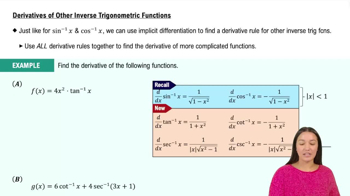Using identities Use the identity sin 2x=2 sin x cos x sin 2 to find d/dx (sin 2x). Then use the identity cos 2x = cos² x−sin² x to express the derivative of sin 2x in terms of cos 2x.
Table of contents
- 0. Functions7h 54m
- Introduction to Functions16m
- Piecewise Functions10m
- Properties of Functions9m
- Common Functions1h 8m
- Transformations5m
- Combining Functions27m
- Exponent rules32m
- Exponential Functions28m
- Logarithmic Functions24m
- Properties of Logarithms36m
- Exponential & Logarithmic Equations35m
- Introduction to Trigonometric Functions38m
- Graphs of Trigonometric Functions44m
- Trigonometric Identities47m
- Inverse Trigonometric Functions48m
- 1. Limits and Continuity2h 2m
- 2. Intro to Derivatives1h 33m
- 3. Techniques of Differentiation3h 18m
- 4. Applications of Derivatives2h 38m
- 5. Graphical Applications of Derivatives6h 2m
- 6. Derivatives of Inverse, Exponential, & Logarithmic Functions2h 37m
- 7. Antiderivatives & Indefinite Integrals1h 26m
- 8. Definite Integrals4h 44m
- 9. Graphical Applications of Integrals2h 27m
- 10. Physics Applications of Integrals 3h 16m
- 11. Integrals of Inverse, Exponential, & Logarithmic Functions2h 31m
- 12. Techniques of Integration7h 41m
- 13. Intro to Differential Equations2h 55m
- 14. Sequences & Series5h 36m
- 15. Power Series2h 19m
- 16. Parametric Equations & Polar Coordinates7h 58m
3. Techniques of Differentiation
Derivatives of Trig Functions
Problem 3.R.32
Textbook Question
9–61. Evaluate and simplify y'.
y = csc⁵ 3x
 Verified step by step guidance
Verified step by step guidance1
First, recognize that the problem involves differentiating a function. We need to find the derivative of y with respect to x, denoted as y'.
The given function is y = csc⁵(3x). To differentiate this, apply the chain rule. The chain rule states that if you have a composite function f(g(x)), the derivative is f'(g(x)) * g'(x).
Identify the outer function as f(u) = u⁵, where u = csc(3x). The derivative of u⁵ with respect to u is 5u⁴.
Next, differentiate the inner function u = csc(3x). The derivative of csc(x) is -csc(x)cot(x), so the derivative of csc(3x) is -csc(3x)cot(3x) * 3, using the chain rule again.
Combine these results using the chain rule: y' = 5(csc(3x))⁴ * (-csc(3x)cot(3x) * 3). Simplify the expression by multiplying the constants and combining like terms.
 Verified video answer for a similar problem:
Verified video answer for a similar problem:This video solution was recommended by our tutors as helpful for the problem above
Video duration:
3mPlay a video:
Was this helpful?
Key Concepts
Here are the essential concepts you must grasp in order to answer the question correctly.
Differentiation
Differentiation is a fundamental concept in calculus that involves finding the derivative of a function. The derivative represents the rate of change of the function with respect to its variable. In this case, we need to differentiate the function y = csc⁵(3x) to find y'.
Recommended video:

Finding Differentials
Chain Rule
The Chain Rule is a technique used in differentiation when dealing with composite functions. It states that the derivative of a composite function is the derivative of the outer function evaluated at the inner function, multiplied by the derivative of the inner function. For y = csc⁵(3x), applying the Chain Rule is essential to correctly differentiate the function.
Recommended video:

Intro to the Chain Rule
Trigonometric Derivatives
Trigonometric derivatives are the derivatives of trigonometric functions, which have specific rules. For example, the derivative of csc(x) is -csc(x)cot(x). Understanding these rules is crucial for differentiating y = csc⁵(3x), as we will need to apply the derivative of the csc function in our calculations.
Recommended video:

Derivatives of Other Inverse Trigonometric Functions

 3:53m
3:53mWatch next
Master Derivatives of Sine & Cosine with a bite sized video explanation from Patrick
Start learningRelated Videos
Related Practice
